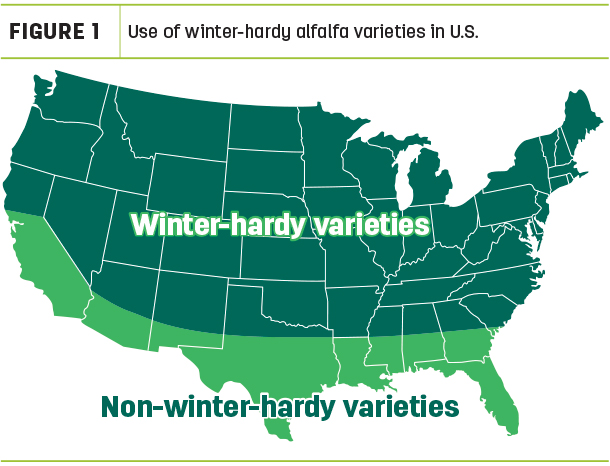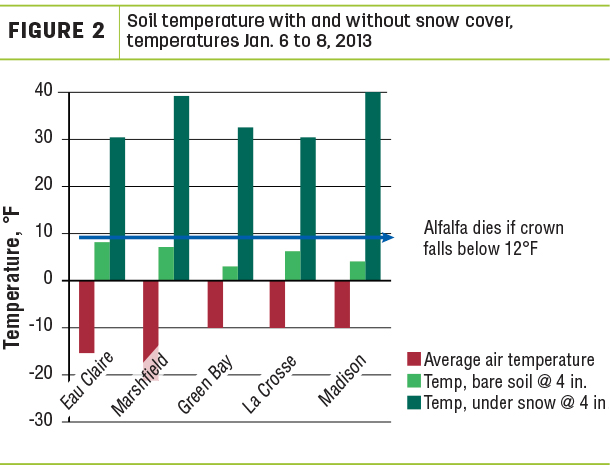Summer alfalfa is different in structure than hardened or winterized alfalfa. Summer alfalfa will freeze and die at 32ºF, while winterized alfalfa can survive temperatures (in the root zone) of as low as 13ºF and even colder air temperatures (Figure 1).
During fall hardening, the fatty acid membrane around each cell becomes more unsaturated (fewer double bonds between carbon atoms). A saturated membrane is better for summer growth and root reserve building, since it allows freer movement of carbohydrates out of the cell and minerals into the cell. However, the unsaturated membrane can survive colder temperatures without solidifying, which would cause cell death.
Additionally, hardened cells have higher contents of sugars, which act as an antifreeze, allowing cell contents to remain liquid at lower temperatures (the same reason regular Coke or 7Up freezes at colder temperatures than diet versions with less sugar).

These and other changes cause ice formation in spaces between cells rather than inside the cell. Water loss from inside cells is reduced with extracellular freezing (most winterkill is actually due to desiccation – water loss – from cells).
Hardening begins in the fall when crown temperature is 60ºF, with maximum hardening occurring when the air temperature is between 40ºF and 50ºF. Hardening is increased by fluctuating temperatures, with highs around 50ºF and lows near freezing.
How much a plant hardens depends both on the plant’s genetic potential and weather conditions. We can think of hardening as a sliding scale with 100% of genetic potential developing with three weeks of cool days and near-freezing nights and less of the genetic potential for winter hardening developing with shorter periods of fluctuating temperatures. Thus, alfalfa hardening and its ability to survive winter will be greater in some years than others, depending on fall weather.
Degree of hardening is also affected by management. Low soil fertility reduces winter survival (particularly, low soil pH and low levels of potassium and sulfur). More frequent cutting (e.g., 28- versus 35-day intervals) requires more genetic winter hardiness because plants have less time between cuttings to replenish root carbohydrates. Additionally, late fall cutting, while often recommended, puts more stress on alfalfa and requires more winter hardiness.
Drought-induced dormant alfalfa may survive the winter and grow next spring, if then receiving water. However, soil moisture below 50% of field capacity over winter may increase winterkill due to desiccation of alfalfa. Avoid irrigating drought-induced dormant alfalfa until late in the fall, when lower temperatures will maintain alfalfa dormancy, preserving stored root reserves for winter maintenance and spring growth.
Snow cover has a huge impact on alfalfa survival. Figure 2 shows soil temperatures for a few days when air temperature was -10ºF or less at five locations in Wisconsin.

Hardened alfalfa can generally survive soil temperatures as low at 13ºF. Note that soil temperature at 4 inches was 5ºF to 10ºF in soil with no snow cover, which was cold enough to have killed alfalfa, while soil temperature under 6 to 8 inches of snow was 30ºF or higher.
Thus, when preparing for winter, consider the following:
First, determine if the stand is worth keeping. Stem density, not plant density, determines yield potential. Fifty-five stems per square foot are required for maximum yield (25 stems per square foot in nonirrigated, dryland regions). You can count cut ends after mowing.
If, for example, the stand has 40 stems per square foot this fall, then one would expect a 25% yield reduction from maximum for the next year. If you decide to keep an irrigated stand with less than 55 stems per square foot, not only will yield be reduced, but you may need to control weeds, either this fall or next spring.
Second, manage for high alfalfa-root carbohydrate levels going into the winter. Take the last cutting of alfalfa either when the plant will have 500 growing degree days (base 41ºF) to grow and replenish root carbohydrates or less than 200 growing degree days, so little regrowth and root carbohydrate use occurs. Entering the winter with 6 to 8 inches of regrowth is the worst possible situation.
Third, late-summer fertilization should be done to replace nutrients removed by the alfalfa forage. Each ton of alfalfa dry matter removes about 14 pounds of phosphate (P2O5), 55 pounds of potash (K2O), and 6 pounds of sulfur. Many western soils do not need additional potassium fertilization. Most dairy farms apply sufficient manure to meet phosphorus needs. All soils need sulfur, unless irrigation water content of sulfur is high. Fertilizing to replenish soil nutrients ahead of the last cutting will enhance winter survival and increase growth of first cutting next year. Remember, also, to apply 1 pound per acre of boron annually.
Fourth, check fields for weeds and decide whether or not a fall application of herbicide would be beneficial. Alfalfa is competitive with many weeds if a dense stand is present, but winter annual weeds can be especially problematic. They grow later in the fall and start growing early in the spring to cause stand thinning.
Some weeds, such as chickweed, can cause stand loss and mature ahead of alfalfa to lower the quality of first-cutting alfalfa. In addition, heavy infestations of chickweed can delay drying due to high weed-moisture content.
Additionally, some weeds will reduce forage palatability and have varying degrees of toxicity to cattle, horses, goats and sheep, such as yellow rocket, field pennycress, henbit, purple deadnettle, curly dock and cressleaf groundsel.
One should assess the weed problem and then plan on a fall or dormant application of herbicide to control problem weeds. In some regions, dormancy of alfalfa may be difficult to determine. Glyphosate herbicides can be applied before dormancy in the fall or during spring greenup if Roundup Ready alfalfa was planted.
Fifth, where irrigation is available, consider that the most critical irrigation is the late summer or autumn irrigation. Good levels of soil moisture at this time permit foliage regrowth and root carbohydrate accumulation for overwintering, lessen rapid temperature changes that damage roots, prevent crown and root drying and provide stored moisture for the next growing season. Dry soils during winter often cause stand declines. Maintain soil water content between 50% and 70% of the available water-holding capacity. The deeper portion of the soil profile can be refilled in this off-season period.











